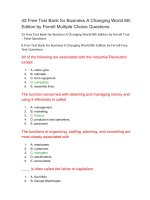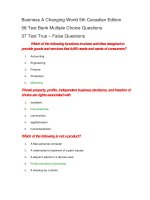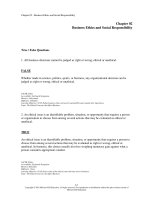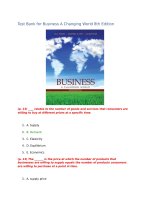Business a changing world 7e by ferrell chap011
Bạn đang xem bản rút gọn của tài liệu. Xem và tải ngay bản đầy đủ của tài liệu tại đây (6.76 MB, 48 trang )
11-1
Business in a
Changing World
Chapter 11
Managing Human Resources
2
McGraw-Hill/Irwin
Copyright © 2009 by the McGraw-Hill Companies, Inc. All rights
11-3
Amadeus Consulting: Where
Employees are the Company
Lisa Calkins and John Basso have created a
company for which people are motivated to
work for the long term.
11-4
Managing Human Resources
Human Resources Management – all the
activities involved in determining the
organization’s needs for human resources and
acquiring, training, and compensating people to
fill those needs.
11-5
Managing Human Resources
HRM
Increasing in importance – Employee Concerns:
•Compensation
•Job satisfaction
•Personal performance
•Leisure
•Environment
•Opportunities for advancement
11-6
What is the Primary Reason you Accepted
Your Job?
Source: Snapshots, USA Today, March 13, 2008, p. B1
11-7
Planning – Human Resource Needs
•Job analysis – systematically determining pertinent
information about a job (tasks, abilities, knowledge, skills)
•Job description -- formal & written specifications of the job
(title, tasks, relationships, skills, duties, responsibilities).
•Job specification – description of the job qualifications
(education, experience, personal/physical characteristics).
11-8
Employee Recruiting & Selection
•Recruiting – the formation of a pool of qualified job candidates
from which management selects employees.
•Internal Sources
•Current employees
•Promotion from within
•External Sources
•advertising
•Employment agencies
•Online - Monster.com; Hotjobs.com
11-9
Employee Recruiting & Selection
•Selection – the process of collecting information about
applicants and using information to make hiring decisions.
•Application
•Interviewing
•Testing
•Reference Checking
11-10
Employee Recruiting & Selection
•Application --
•First stage of the selection process
•Name, address, telephone
•Education, previous work experience, references
•Qualifications for the position
11-11
Employee Recruiting & Selection
•Interview --
•2nd phase of selection
•Detailed information on candidate (applicant)
•Attitudes toward job
11-12
Employee Recruiting & Selection
•Testing --
•Ability and performance testing
•Aptitude, IQ, Personality tests
•Applicant assessment
•Goodness of “fit”
•Myers-Briggs Type Indicator
11-13
Employee Recruiting & Selection
Top 10 Interview Questions
11-14
Recruiting & Selecting Employees
Top 10 Mistakes Made in Interviewing
1. Not taking the interview seriously
2. Not dressing appropriately (dressing down)
3. Not appropriately discussing experience and education
4. Being too modest about one’s accomplishments
5. Talking too much
6. Too much concern about compensation
7. Speaking negatively of a former employer
8. Not asking enough or appropriate questions
9. Not showing the proper enthusiasm level
10. Not engaging in appropriate follow-up to interview
11-15
Employee Recruiting & Selection
•Reference Checking --
•Verifying education
•Previous work experience
•Privacy issues
11-16
Recruiting & Selecting Employees
Sampling of Psychological Tests
11-17
Legal Issues in Recruiting & Selection
Title VII of the Civil Rights Act -•Prohibits discrimination in employment
•Equal Employment Opportunity Commission (EEOC)
•Tests must be validated
11-18
Legal Issues in Recruiting & Selection
Laws affecting HRM -•Americans with
Disabilities Act (ADA)
•Age Discrimination in
Employment Act
•Equal Pay Act
11-19
Training & Development
Training -- teaching employees to do specific job
tasks through classroom development or on-the-job
experience.
Development – training that augments the skills
and knowledge of managers and professionals.
11-20
Training & Development
HiPiHi, Novo King, UOneNet – Stimulate new training concepts
11-21
Assessing Performance
Performance Assessment –
•Strengths
•Weaknesses
•Provides feedback
•Objective or subjective
•Quantitative or qualitative
11-22
Performance Characteristics
11-23
Turnover
Turnover – employees voluntarily leave (quit); involuntary leave
(fired). Management must replace workers.
Promotion – advancement to higher-level job with increased
authority, responsibility, and pay
Transfer – move to another job within the company usually at same or
similar level and wage rate
Separations – employment changes involving resignation, retirement,
termination, or layof
11-24
Compensating the Workforce
Reasons Employees Stay in Their Current Jobs
11-25









